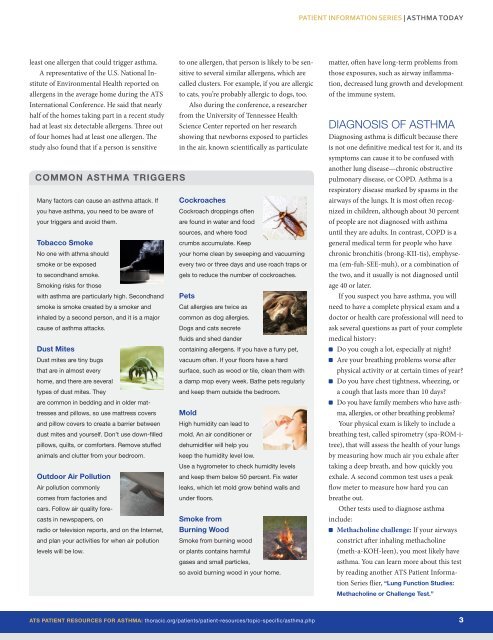Asthma Today
SQrxm
SQrxm
- No tags were found...
Create successful ePaper yourself
Turn your PDF publications into a flip-book with our unique Google optimized e-Paper software.
PATIENT INFORMATION SERIES | ASTHMA TODAY<br />
least one allergen that could trigger asthma.<br />
A representative of the U.S. National Institute<br />
of Environmental Health reported on<br />
allergens in the average home during the ATS<br />
International Conference. He said that nearly<br />
half of the homes taking part in a recent study<br />
had at least six detectable allergens. Three out<br />
of four homes had at least one allergen. The<br />
study also found that if a person is sensitive<br />
COMMON ASTHMA TRIGGERS<br />
Many factors can cause an asthma attack. If<br />
you have asthma, you need to be aware of<br />
your triggers and avoid them.<br />
Tobacco Smoke<br />
No one with athma should<br />
smoke or be exposed<br />
to secondhand smoke.<br />
Smoking risks for those<br />
with asthma are particularly high. Secondhand<br />
smoke is smoke created by a smoker and<br />
inhaled by a second person, and it is a major<br />
cause of asthma attacks.<br />
Dust Mites<br />
Dust mites are tiny bugs<br />
that are in almost every<br />
home, and there are several<br />
types of dust mites. They<br />
are common in bedding and in older mattresses<br />
and pillows, so use mattress covers<br />
and pillow covers to create a barrier between<br />
dust mites and yourself. Don’t use down-filled<br />
pillows, quilts, or comforters. Remove stuffed<br />
animals and clutter from your bedroom.<br />
Outdoor Air Pollution<br />
Air pollution commonly<br />
comes from factories and<br />
cars. Follow air quality forecasts<br />
in newspapers, on<br />
radio or television reports, and on the Internet,<br />
and plan your activities for when air pollution<br />
levels will be low.<br />
to one allergen, that person is likely to be sensitive<br />
to several similar allergens, which are<br />
called clusters. For example, if you are allergic<br />
to cats, you’re probably allergic to dogs, too.<br />
Also during the conference, a researcher<br />
from the University of Tennessee Health<br />
Science Center reported on her research<br />
showing that newborns exposed to particles<br />
in the air, known scientifically as particulate<br />
Cockroaches<br />
Cockroach droppings often<br />
are found in water and food<br />
sources, and where food<br />
crumbs accumulate. Keep<br />
your home clean by sweeping and vacuuming<br />
every two or three days and use roach traps or<br />
gels to reduce the number of cockroaches.<br />
Pets<br />
Cat allergies are twice as<br />
common as dog allergies.<br />
Dogs and cats secrete<br />
fluids and shed dander<br />
containing allergens. If you have a furry pet,<br />
vacuum often. If your floors have a hard<br />
surface, such as wood or tile, clean them with<br />
a damp mop every week. Bathe pets regularly<br />
and keep them outside the bedroom.<br />
Mold<br />
High humidity can lead to<br />
mold. An air conditioner or<br />
dehumidifier will help you<br />
keep the humidity level low.<br />
Use a hygrometer to check humidity levels<br />
and keep them below 50 percent. Fix water<br />
leaks, which let mold grow behind walls and<br />
under floors.<br />
Smoke from<br />
Burning Wood<br />
Smoke from burning wood<br />
or plants contains harmful<br />
gases and small particles,<br />
so avoid burning wood in your home.<br />
matter, often have long-term problems from<br />
those exposures, such as airway inflammation,<br />
decreased lung growth and development<br />
of the immune system.<br />
DIAGNOSIS OF ASTHMA<br />
Diagnosing asthma is difficult because there<br />
is not one definitive medical test for it, and its<br />
symptoms can cause it to be confused with<br />
another lung disease—chronic obstructive<br />
pulmonary disease, or COPD. <strong>Asthma</strong> is a<br />
respiratory disease marked by spasms in the<br />
airways of the lungs. It is most often recognized<br />
in children, although about 30 percent<br />
of people are not diagnosed with asthma<br />
until they are adults. In contrast, COPD is a<br />
general medical term for people who have<br />
chronic bronchitis (brong-KII-tis), emphysema<br />
(em-fuh-SEE-muh), or a combination of<br />
the two, and it usually is not diagnosed until<br />
age 40 or later.<br />
If you suspect you have asthma, you will<br />
need to have a complete physical exam and a<br />
doctor or health care professional will need to<br />
ask several questions as part of your complete<br />
medical history:<br />
Do you cough a lot, especially at night?<br />
Are your breathing problems worse after<br />
physical activity or at certain times of year?<br />
Do you have chest tightness, wheezing, or<br />
a cough that lasts more than 10 days?<br />
Do you have family members who have asthma,<br />
allergies, or other breathing problems?<br />
Your physical exam is likely to include a<br />
breathing test, called spirometry (spa-ROM-itree),<br />
that will assess the health of your lungs<br />
by measuring how much air you exhale after<br />
taking a deep breath, and how quickly you<br />
exhale. A second common test uses a peak<br />
flow meter to measure how hard you can<br />
breathe out.<br />
Other tests used to diagnose asthma<br />
include:<br />
Methacholine challenge: If your airways<br />
constrict after inhaling methacholine<br />
(meth-a-KOH-leen), you most likely have<br />
asthma. You can learn more about this test<br />
by reading another ATS Patient Information<br />
Series flier, “Lung Function Studies:<br />
Methacholine or Challenge Test.”<br />
ATS PATIENT RESOURCES FOR ASTHMA: thoracic.org/patients/patient-resources/topic-specific/asthma.php 3


